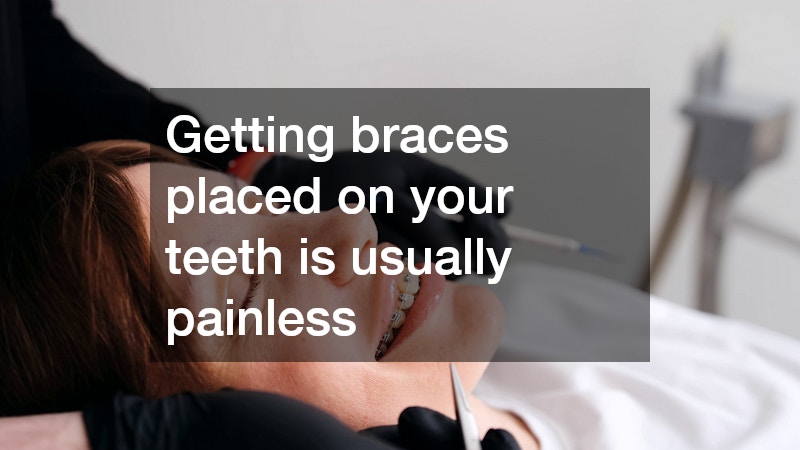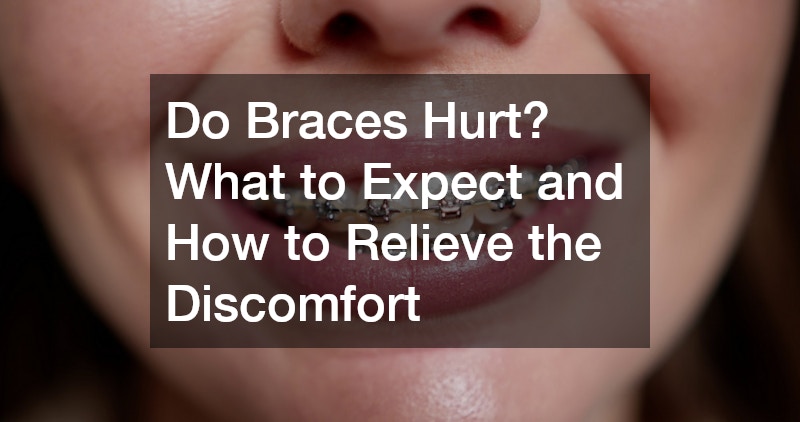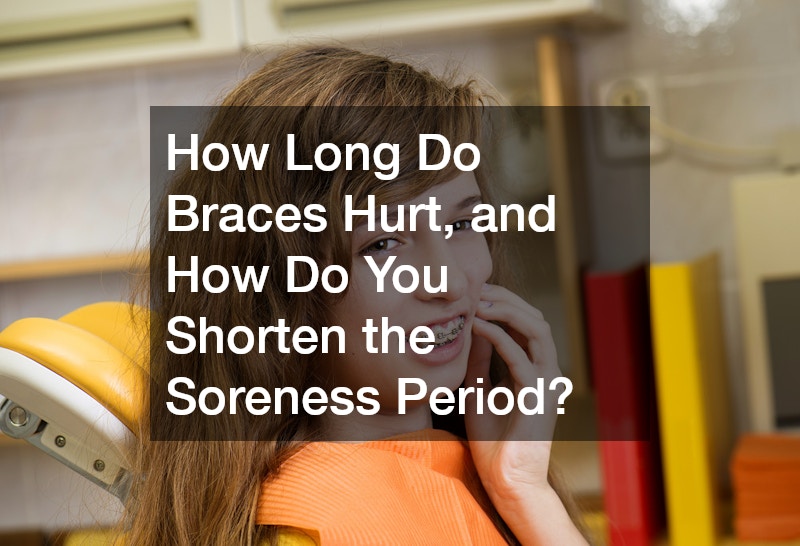
If you’re about to get braces or your child is starting orthodontic treatment, you might be wondering the big question: Do braces hurt? The short answer is yes, but not in the way you might think. While braces aren’t generally painful during the actual placement, you can expect some soreness or discomfort in the days following adjustments.
In this guide, we’ll break down what to expect, why braces cause discomfort, and how you can make the process more comfortable from day one until the braces come off.
Understanding How Braces Work
Before we talk about pain, it helps to really understand why braces cause discomfort in the first place. Braces aren’t just pieces of metal stuck to your teeth—they’re a carefully engineered orthodontic system designed to gradually guide your teeth into better alignment over time.
Braces work by applying gentle, consistent pressure to your teeth. This steady force is what slowly shifts them into a straighter position. Your body responds to this force by remodeling the bone around each tooth—a natural process called bone resorption and deposition. The bone in the direction your tooth is moving softens slightly so the tooth can shift, while new bone forms behind it to secure it in place. This process is healthy and intentional, but it’s also why you might feel some tenderness after adjustments.
Here are the main components of braces and how they work together:
Brackets
These are the small metal or ceramic “anchors” that your orthodontist bonds directly to each tooth. Brackets serve as handles for the wires to hold onto. Their placement is precise because even a small shift in bracket positioning can change how the tooth moves. Ceramic brackets are less noticeable than metal ones but function in the same way.
Archwire
This is the thin, flexible wire threaded through all the brackets. It’s shaped to match your ideal smile alignment. When the wire is engaged, it naturally wants to return to its original shape, gently guiding your teeth into that position over time. Different wire materials and thicknesses are used throughout treatment to control the speed and direction of movement.
Bands and Elastics
Bands are metal rings that fit around the back molars, anchoring the archwire in place. Elastics (rubber bands) may be used to connect brackets in specific patterns, adding targeted tension to correct bite issues like overbites, underbites, or midline shifts. These elastics create additional pulling forces that help fine-tune your bite.
This constant, controlled pressure sets off a chain reaction in your gums, periodontal ligaments, and jawbone. While it’s a safe and natural process, the tissues are sensitive to change, which is why you may notice soreness for a short period after each adjustment. Over time, as your mouth adapts, these periods of discomfort become shorter and easier to manage.
Do Braces Hurt When They’re Put On?

Here’s the good news: Getting braces placed on your teeth is usually painless. In fact, many people are surprised at how simple and non-invasive the process is. There’s no drilling, no injections, and no removal of tooth structure—just careful preparation and placement.
Here’s what typically happens during the appointment:
Cleaning and Drying Your Teeth
Your orthodontist or dental assistant will thoroughly clean your teeth to remove any plaque or debris. A clean surface ensures the bonding material sticks properly. Your teeth are then dried, and a cheek retractor is used to keep your mouth open and moisture-free during the process.
Applying the Bonding Agent
A special dental adhesive is painted onto the surface of each tooth where a bracket will be placed. This glue is safe, strong, and designed to hold the brackets securely throughout treatment. Sometimes a mild etching solution is used beforehand to create a better surface for the glue to bond to.
Attaching the Brackets
Each bracket is positioned with precision to ensure the desired tooth movement. The orthodontist places the bracket, adjusts its position for accuracy, and then cures (hardens) the bonding agent with a special blue light.
Threading the Archwire
Once all brackets are in place, the orthodontist threads the archwire through the slots in each bracket. This is the part that begins the movement process. At first, the wire may be very flexible—perfect for gently starting tooth movement without overwhelming your mouth.
Securing with Elastic Ties
Tiny elastic rings (called ligatures) are placed over each bracket to hold the wire in position. These come in a variety of colors, and you can choose to go subtle or have some fun with your look.
The whole process usually takes about 1–2 hours, depending on how many adjustments or extra components are needed. While you may feel a little pressure when the wire is first engaged, you won’t feel pain during the placement.
When Braces Start to Hurt (and How Long It Lasts)
Most people report mild to moderate soreness during the first 3–7 days after getting braces or after a tightening appointment. The discomfort is not sharp pain—it’s more of a dull ache or tenderness.
Here’s a typical timeline:
- First 6 hours: Teeth may feel a bit tight but manageable.
- 24 hours later: Soreness becomes more noticeable as pressure builds.
- Days 2–3: Peak discomfort—chewing harder foods can be challenging.
- By day 5–7: The soreness usually fades significantly.
After the initial adjustment period, most people only feel discomfort for a couple of days following each adjustment appointment.
Why Braces Can Be Uncomfortable
Pain or discomfort from braces isn’t the same for everyone—some people only feel mild soreness, while others notice more persistent tenderness. Your experience depends on factors like age, pain tolerance, the complexity of your orthodontic case, and how your body responds to tooth movement.
Here are the most common reasons braces can cause discomfort and why they happen:
1. Pressure on Teeth and Gums
The main purpose of braces is to apply steady, gentle pressure to your teeth. This pressure activates the periodontal ligament (the connective tissue that holds your teeth in place) and starts the process of bone remodeling. While this movement is gradual, your teeth, gums, and surrounding bone tissues still need time to adapt. This adaptation can make your teeth feel tender, especially when you bite down or chew. It’s not sharp pain—it’s more of a deep, achy sensation that tends to peak in the first couple of days after an adjustment.
2. Irritation from Brackets and Wires
The inside of your mouth is soft and sensitive, so when brackets and wires are introduced, there’s an adjustment period. Brackets may rub against the inside of your cheeks or lips, and wires—especially if slightly protruding—can cause small sores or rough spots. Orthodontic wax is a quick fix for this, but in the first few weeks, you might notice more friction as your mouth “toughens up” and develops a protective layer of tissue.
3. Jaw Soreness from Bite Correction
If your orthodontic plan involves elastics (rubber bands) or other appliances to correct your bite, your jaw muscles and joints may feel sore. These elastics work by pulling the jaw into a new position, which can strain muscles you don’t normally use in that way. For some people, this soreness can also cause mild headaches or a feeling of tightness when opening and closing the mouth. Fortunately, your jaw adapts with time, and any discomfort usually decreases as your muscles get used to the new positioning.
4. Inflammation from Tooth Movement
Whenever your teeth are moved, your body responds with mild inflammation in the surrounding tissues. This is completely normal—it’s part of the healing and adjustment process. Inflammation can make your gums feel swollen or tender, particularly during the first few days after an adjustment. Good oral hygiene, saltwater rinses, and staying hydrated can help keep inflammation to a minimum.
Is the Pain from Braces Severe?
Most people describe braces discomfort as annoying rather than unbearable. It’s similar to the soreness you feel after a tough workout—your body is adjusting to something new. Severe or sharp pain is not typical and should be reported to your orthodontist right away.
How to Relieve Braces Discomfort Quickly

The good news is that there are plenty of simple, effective ways to make braces more comfortable. You don’t have to suffer through the adjustment period—using the right tools and habits can make a noticeable difference in how quickly you recover from soreness.
Here are the most effective strategies:
1. Over-the-Counter Pain Relief
If your teeth feel sore after getting braces or following an adjustment, over-the-counter pain relievers like ibuprofen (Advil, Motrin) or acetaminophen (Tylenol) can help reduce discomfort. Ibuprofen is especially useful because it also reduces inflammation in the gums and ligaments.
Pro tip: Take your first dose about an hour before your orthodontic appointment so the medication kicks in by the time the soreness begins. Always follow the recommended dosage instructions, and check with your orthodontist or healthcare provider before taking any medication, especially for children.
2. Orthodontic Wax
One of the most common sources of discomfort isn’t the movement of your teeth—it’s the rubbing of brackets and wires against the inside of your cheeks or lips. Orthodontic wax acts as a soft cushion between the hardware and your mouth.
Simply pinch off a small piece, roll it into a ball, and press it over the irritating bracket or wire. Replace the wax as needed, especially after eating or brushing. Over time, your mouth will build up small areas of tougher tissue, reducing the need for wax, but it’s always good to keep some on hand.
3. Soft Foods Diet
During the first few days after getting braces—or after each tightening—it’s best to give your teeth a break by sticking to soft foods that require minimal chewing. This helps avoid extra strain on sensitive teeth and gums.
Soft food ideas include:
- Yogurt
- Mashed potatoes
- Applesauce
- Smoothies
- Oatmeal
- Scrambled eggs
- Cottage cheese
- Pasta or noodles
Foods to avoid during soreness: Anything crunchy (chips, raw carrots), sticky (caramel, gum), or tough to chew (bagels, steak). Not only can these foods cause pain when chewing, but they can also damage your braces.
4. Saltwater Rinse
A warm saltwater rinse can do wonders for braces discomfort, especially if you have small sores or irritated spots inside your mouth. The salt acts as a mild antiseptic, helping reduce swelling and promoting healing.
To make a rinse:
- Mix ½ teaspoon of salt into 1 cup of warm water.
- Swish gently in your mouth for about 30 seconds.
- Spit out the water—don’t swallow it.
- Repeat 2–3 times a day as needed.
This is a safe, inexpensive, and natural way to ease mouth irritation.
5. Cold Compress or Ice Water
Cold temperatures help numb sore spots and reduce inflammation in the gums and jaw. You can use this to your advantage in a couple of ways:
- Cold compress: Apply an ice pack or cold gel pack to the outside of your cheek for 10–15 minutes at a time.
- Ice water: Slowly sip ice water to soothe tender teeth and gums.
Just be careful with ice cubes—chewing them can damage braces and teeth. Stick to sipping or letting the cold water sit briefly in your mouth.
6. Silicone Bite Pads (Bite Wafers)
Orthodontic bite wafers—small, flexible pads you gently chew on—can actually help speed up the adjustment period. By lightly biting down on them, you increase blood flow to the gums and periodontal ligaments, which can reduce stiffness and promote healing.
Bite wafers also help relieve the “tight” feeling that comes after adjustments. They’re especially useful in the first few days of treatment and can be purchased online or through your orthodontist’s office.
Extra Comfort Tip: Staying hydrated and maintaining good oral hygiene can also reduce discomfort. A clean mouth heals faster, and plenty of water helps keep tissues hydrated, preventing dryness and irritation.
What to Expect at Adjustment Appointments
Every 4–8 weeks, your orthodontist will adjust your braces to continue the movement process. During these visits, you might experience:
- Tightening of the archwire
- Replacement of elastic ties
- Adding new rubber bands or springs
These adjustments usually lead to another 1–3 days of mild discomfort, but it’s generally less intense than the first week of getting braces.
Common Myths About Braces Pain
Let’s clear up a few misconceptions so you know what’s fact and what’s fiction.
Myth 1: Braces are unbearably painful.
Reality: They cause mild soreness, but it’s manageable with simple home remedies.
Myth 2: Pain means something is wrong.
Reality: Mild discomfort is normal—sharp or prolonged pain is when you should call your orthodontist.
Myth 3: The more it hurts, the faster your teeth move.
Reality: Pain isn’t a sign of faster movement—it’s simply your mouth adjusting.
When to Call Your Orthodontist About Pain
While most discomfort is normal, contact your orthodontist if you experience:
- Severe, persistent pain lasting more than a week.
- Wires poking into your gums or cheeks.
- Broken brackets or loose wires.
- Mouth sores that don’t heal.
Prompt adjustments can prevent small issues from turning into big problems.
Braces Pain: Kids vs. Adults
Many people ask whether kids or adults have more discomfort with braces. In general:
- Kids and teens often adapt faster because their teeth and bones are still developing.
- Adults may feel soreness longer after adjustments since their bone structure is denser.
However, the difference isn’t dramatic, and pain management strategies work for all ages.
How to Mentally Prepare for Braces Discomfort
Pain is partly physical, partly mental. Knowing what to expect can make the experience easier.
- Stay positive – Remember the end goal: a healthier, more confident smile.
- Don’t compare experiences – Everyone’s pain tolerance is different.
- Plan ahead – Stock up on soft foods and pain relief before your appointment.
Tips for Keeping Your Mouth Comfortable Long-Term
Once you’ve gotten past the initial adjustment period, you can prevent unnecessary discomfort by:
- Brushing and flossing carefully to avoid gum inflammation.
- Using an interdental brush to clean around brackets.
- Wearing a mouthguard if you play sports.
- Avoiding hard or sticky foods that can damage braces.
Life After Braces: Is There Pain with Retainers?
When your braces come off, your orthodontist will likely give you a retainer to keep your teeth from shifting back. Wearing a retainer may cause mild tightness at first, but it’s nothing compared to the initial braces adjustment. Consistent wear helps your teeth stay in their new positions—and keeps you from having to repeat the process.
Final Thoughts: Braces and Pain Don’t Have to Be a Big Deal
So, do braces hurt? Yes, but it’s temporary, predictable, and manageable. The first few days after getting braces or following adjustments will be the most uncomfortable, but simple remedies like soft foods, orthodontic wax, saltwater rinses, and over-the-counter pain relievers can make a world of difference.
Think of braces discomfort as a small trade-off for a big reward—a straight, healthy smile that lasts a lifetime. With the right mindset and preparation, you’ll handle the process like a pro.


